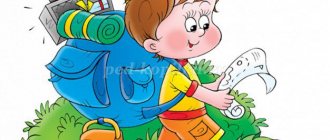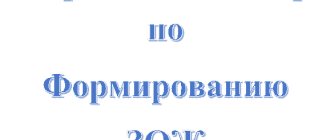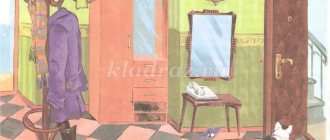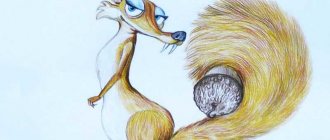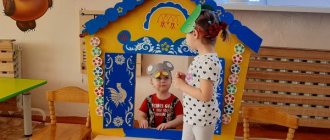Project "Children's Economy"
Kindergarten preparatory group
Project content
Project name: “Children's Economy”.
Project type : educational, creative, informational.
Duration : short-term (2 weeks - from January 15 to January 29, 2022).
Content : socio-pedagogical, informational.
By the nature of contacts : teacher - child - parent, within the preschool educational institution.
Participants: children of preparatory group No. 17, teachers, parents.
Educational areas: “Cognitive development”, “Socio-communicative development”, “Speech development”, “Artistic and aesthetic development”, “Physical development”.
Problem: lack of awareness among children about finances.
Relevance:
In the modern world it is very difficult to live without economic knowledge.
The basics of economics are not taught in preschool educational institutions, despite the fact that knowledge about finances and the ability to distribute them competently, taking into account opportunities, needs and desires, opens up good opportunities and contributes to the financial well-being of children when they grow up.
Teaching economic culture to preschoolers is not limited to teaching children how to earn money in the future. In preschool age, the basics of financial literacy should initially be instilled through basic moral ideas: about good and evil, beautiful and ugly, good and bad. The main task is to give the concept of a thrifty attitude towards things, natural resources, and then money.
The earlier children learn about the role of money, the earlier healthy financial habits can be formed.
Children, one way or another, are involved early in the economic life of the family: they encounter money, go to the store with their parents, and acquire primary economic knowledge.
Children should know that they must live within their means, they must spend less than they earn, that a sufficient amount of financial resources opens up great opportunities for them that can give them joy.
Formation of the foundations of financial literacy in preschool age must be carried out from simple to complex, in a playful form understandable to children. It is in preschool age that we have a unique opportunity to give children the basics of financial literacy and primary experience in participating in basic economic relations.
All this makes relevant the problem of developing basic economic concepts and developing financial literacy in preschool age.
Project goals: to create conditions for the formation of the basics of financial literacy in preschool children.
Tasks:
for children:
- To promote the formation of initial ideas about money as a universal means of exchange, payment and accumulation;
- Contribute to the formation of initial ideas about the family budget and the importance of financial literacy in the family economy;
- To contribute to the formation of ideas about the relationship between the concepts “labor - product - money”, “quality - price”;
- To promote the formation of knowledge about the qualities: frugality, rationality, economy, hard work, generosity, nobility, honesty, responsiveness, empathy (using the example of a person’s wealth in financial and moral terms);
- To promote the formation of the ability to rationally evaluate ways and means of fulfilling desires, and adjust one’s own needs;
- Develop the creative abilities of preschoolers in various activities;
- Develop the skills to analyze, reason, generalize, compare, contrast, and draw conclusions;
- Develop children's interest in financial literacy through games, quizzes, and events;
- To instill in children purposefulness, organization, initiative, hard work, and mutual assistance;
- To cultivate the value and respect for human work and the surrounding objective world, as a result of people’s labor.
for teachers:
- Create conditions for students to successfully master knowledge about the basics of economics and financial literacy;
- Prepare children for the final event on financial literacy “Visiting Pinocchio and Alice” among pupils of groups of senior preschool children of preschool educational institutions.
for parents:
- Developing interest in the economic education of children together with preschool educational institutions;
- Forming the foundations of financial literacy in children through a personal example of competent distribution of their financial capabilities, taking into account their needs and desires in practice;
- Strengthening relationships between adults and children.
Practical significance: the formation of financial literacy in preschool educational institutions brings preschoolers closer to real life, promotes the development of economic thinking, allows them to acquire qualities inherent in a real person (dedication, honesty, commitment, the ability to subordinate their desires to opportunities, law-abidingness, mutual assistance, etc.)
Novelty of the project:
The novelty of the “Children’s Economy” project lies in the fact that financial education and economic education are a relatively new direction in preschool pedagogy. This work allows teachers to simultaneously solve several problems of preschool education, namely:
- raising and teaching children;
- development of comprehensive personality development;
- preparing children for independent social life through the formation of the foundations of financial literacy.
Work on this project is carried out by integration into all educational areas of preschool education: “Cognitive development”, “Social and communicative development”, “Speech development”, “Artistic and aesthetic development”, “Physical development”.
As a result of the implementation of the “Children’s Economics” project, children of senior preschool age will form ideas about the basics of economics, which is part of not only financial literacy, but also the aesthetic and moral education of the child.
Expected results:
- Children acquired primary financial experience, the ability to establish reasonable financial relationships in various spheres of life;
- Teachers have practically mastered the first experience of a system of work on developing financial literacy in preschool children;
- Parents received additional knowledge on raising financial literacy in children.
Stages and timing of the project:
Stage 1 - Information and accumulation stage
(from January 11 to January 13, 2022):
- Studying the level of knowledge of senior preschool children of group No. 17 about the basics of economics, identifying the level of financial literacy (ascertaining diagnostics);
- Questioning parents (legal representatives) on the topic “Financial literacy of preschool children”;
- Studying methodological literature, collecting material (fairy tales, poems, riddles, proverbs, active, role-playing games, interactive manuals, educational films and cartoons on the topic of the project) necessary to achieve the goal of the project;
- Drawing up a long-term plan, developing a system of measures aimed at implementing the project;
- Including project cycles in the long-term work plan;
- Involving parents (legal representatives) to participate in joint creative and educational activities with children in the implementation of project activities.
Stage 2 - Organizational and practical stage
(from January 14 to January 20, 2022):
- Reading fiction;
- Examination of illustrations, photographs;
- Joint production of attributes and organization of role-playing games on the topic of the project;
- Watching educational and animated films for children on the topic “Financial literacy of preschoolers”;
- Consultations for parents on the project topic: “Practical advice to parents on developing financial literacy in children of senior preschool age”, “Teach your child to count money”;
- Conducting OOD and joint activities on the project topic.
Stage 3 – Presentation and final stage
(from January 21 to January 27, 2022):
- Studying the level of knowledge of senior preschool children of group No. 17 about the basics of economics, identifying the level of financial literacy (final diagnosis);
- Exhibition of children's activity products;
- Creation and design of collective creative work - book group No. 17 “My needs and desires”;
- Conducting performances by children of group No. 17 on the topic “My Finances”;
- Exhibition “Piggy Banks”;
- Exhibition of joint creative works of children and parents “Do-It-Yourself Piggy Bank”;
- Replenishment of the RPPS with electronic manuals (presentations, interactive games, educational films, cartoons, audio fairy tales) on the topic “Financial literacy of preschoolers”;
- An entertaining event “Visiting Pinocchio and Alice” among pupils of groups of children of senior preschool age at the preschool level.
The implementation of the “Children's Economy” project made it possible to develop in children of senior preschool age knowledge about the basics of financial literacy, to instill in children the desire and desire to replenish, multiply, and maintain their family budget.
Educational areas : social and communicative development, cognitive development, speech development, artistic and aesthetic development, physical development.
Joint activities of children and teachers.
Goal: to intensify cognitive interest in the basics of economics, financial literacy (the history of money, methods of obtaining it, saving, increasing it, budget distribution, etc.).
Cognition
Conversations: “Money and its role in life”, “Why do all adults work?”, “What is financial literacy?”, “Why can’t everything be bought and sold?”, “What are the types of goods?”, “Product - price” , “needs and desires”, “Where does the money live?”, “Budget”, “etc.
Educational films for children: “The History of Money. From martens to paper ones”, “What is a budget and how to draw it up”, “How cash works”, “How and why to save”, “Types of income”, “Types and frequency of expenses”, “Bank cards”, “House of Money” . Banks."
Conducting educational activities and joint activities using interactive manuals on the topic of financial literacy.
Reading fiction
Fairy tales: A.S. Pushkin “The Tale of the Fisherman and the Fish”, S. Ya. Marshak “Cat’s House”, K.I. Chukovsky “Telephone”, Lipsits I.V. “Amazing adventures in the country “Economy”; Popova T.L., Menshikova O.I. “The Tale of Queen Economy, the villainess of Inflation, a magical computer and true friends”; Uspensky E. “The Business of Crocodile Genes”; Kotyusova I.M., Lukyanova R.S. “Economics in fairy tales and games: A manual for educators”, A. Romanov “Miracles in the Wallet”, K. Chukovsky “Tsokotukha Fly”, etc.
Introducing children to proverbs and riddles related to finances.
Socialization
Role-playing games: “Shop”, “Family”, “Bank”, “Post Office”, “Beauty Salon”, etc. (acting out stories, combining several stories into one, etc.)
Productive activities:
HER (artistic design made of paper using the origami technique with drawing elements) “Wallet”;
HER (plastelinography) “Coin”
HER (drawing) “Bill”, “Need - desire”;
Physical development
- Competition games “Wants - Needs”, “Fastest”, “Top up your wallet”;
- Imitation games “Pretend your profession”, “Who does what?”;
Interaction with parents
- Questioning parents (legal representatives) on the topic “Financial literacy of preschool children”;
- Consultations: “Practical advice to parents on developing financial literacy in children of senior preschool age”, “Teach your child to count money”;
- Exhibition "Piggy Bank";
- Exhibition of joint creative works of children and parents “Do-It-Yourself Piggy Bank”;
- Photo exhibition “My personal finances”.
The performance indicators were the following:
For children:
- Children's knowledge about the basics of economics and financial literacy has been developed:
- Knowledge has been formed about money as a universal means of exchange, payment and accumulation, methods of saving and increasing;
- Knowledge has been generated about the family budget and the importance of financial literacy in the family economy;
- Knowledge has been generated about the relationship between the concepts “labor - product - money”, “quality - price”;
- Knowledge has been formed about the qualities: frugality, rationality, thrift, hard work, generosity, nobility, honesty, responsiveness, sympathy (using the example of a person’s wealth in financial and moral terms);
- Knowledge has been formed about the ability to rationally evaluate ways and means of fulfilling desires, and adjust one’s own needs;
- We took part in the entertaining and educational event “Visiting Pinocchio and Alice” among pupils of groups of children of senior preschool age at the preschool level, where children of group No. 17 successfully completed the assigned tasks.
For teachers:
- Increased professional competence of teachers;
- Enrichment of the methodological base on the topic “Formation of financial literacy in preschool children”;
- Strengthening a conscious attitude towards your own budget.
For parents:
- Financial literacy awareness;
- Showing interest in developing the fundamentals of economics and financial literacy together with children;
- Strengthening relationships between adults and children.
The implementation of the “Children's Economics” project made it possible to form and expand the understanding of children in group No. 17 about the basics of economics and financial literacy.
Parents showed interest in developing financial literacy in preschoolers and reflected their impressions in joint creative activities.
Bibliography:
- HELL. Shatova Path to Economics: for classes with children 5-7 years old / VENTANA-GRAF Publishing House, 2015.
- Amend A.F., Salamatov A.A. Formation of moral ideas of preschoolers in the process of economic education // Kindergarten from A to Z. 2003. No. 4. p.55.
- Anoshina L.M. Economic education of older preschoolers in the process of familiarization with new professions // Kindergarten from A to Z. 2003. No. 4. p.103.
- Belokashina S.V. Economy and children. Proverbs and sayings // Preschool pedagogy. 2009. No. 7. p.8.
- Preschoolers about economics: a guide for teachers of institutions providing preschool education / E.N. Tabih. – Minsk: Vysh. school, 2007. – 48 p.: ill.
- Playing economics: comprehensive classes, role-playing games and didactic games / author - comp. L.G. Kireeva. – Volgograd: Teacher, 2008. – 169 p.
- Kryuchkova N.A. Educational and methodological manual for improving financial literacy “First steps on the steps of financial literacy” (for preschoolers), Kaliningrad, 2015.
- Lushnikova E.V. How we play economics //Teacher of the preschool educational institution “TC SPHERE” M.; 2008. No. 11. p.75.
- Methodological recommendations for teaching staff on the implementation of the basic educational program of preschool education in terms of economic education of preschoolers - Moscow, 2022.
- O.A. Blokhina Collection of methodological developments “Formation of the foundations of financial literacy in preschool children. Scenarios of educational events and activities for children and their parents in preschool educational institutions.” — Kaliningrad – 2022.
- Approximate partial educational program for preschool education “Economic education of preschool children: formation of prerequisites for financial literacy” // Bank of Russia. Ministry of Education and Science of the Russian Federation.
- Collection of methodological developments “Scenarios of educational games and educational events on financial literacy for preschool children” - Kaliningrad, 2022.
- Smolentseva A.A. Introduction to the world of economics, or How we play economics: Educational and methodological manual, - St. Petersburg: “Childhood - Press”, 2001. – 176 p.
- Smolentseva A.A. We introduce a preschooler to the basics of economics with the help of fairy tales. M.: ARKTI, 2006. – 88 p.
- Smolentseva A.A. Problem-based game technology for economic education of preschoolers // Kindergarten from A to Z. 2003. No. 4. p.63.
- Yagunova N.M. Introducing preschoolers to economics in creative activities // Kindergarten from A to Z. 2003. No. 4. p.128.
Abstract of educational activities for economic education in the preparatory group “What is a bank?”
3 slide. We enter the bank hall.
Educator: “In the bank premises, there are several halls: in one hall there are counters, bank employees sit behind them (operators, to whom visitors come with coupons. They accept savings books here, like this (I show the book). A savings book looks like a small book , this book cannot be inserted into an ATM, it is accepted by operators.You can also withdraw money from it or pay for something.
4 slide. We move to another room, where they issue a loan.
Educator: -Look, what do you see here?
Children: -Here the hall is divided into booths. There are tables there, and bank employees sit at them. People come up to them and sit at these tables.
Educator: -Consultants work here. When people don’t have enough money of their own to buy something, for example: an apartment, furniture, a car, they go to the bank, and the bank lends them money, that is, on credit. Consultants help people complete the paperwork to get this money. And then people pay back this debt in parts.
Physical exercise “Toys”
We take care of toys (rubbing the shoulders of both hands)
We never get tired of playing them. (twist our palms, while the pads
thumbs touch each other,
the rest are widely spaced)
If something breaks, (casually slap your right hand on your left hand and vice versa)
Then we'll glue it and sew it on. (place the palm of the right hand on the left and vice versa)
Eyes, ears, paws, tail (show on yourself)
Our little animals. (clap your hands to the rhythm)
Both wheels and motor (draw wheels in the air with both hands, then
turn the engine in front of you)
For different toys. (spread hands)
To help mom, (rub your palms)
You need to become thrifty! (wag your index finger)
-We continue our excursion. Guys, who else do you think works at the bank?
5 slide. Educator: -Look, in addition to bank workers, there is also a security guard in the bank. Why do you think security guards are needed in a bank? Children's answers.
Educator: - Security guards guard the bank so that bad people don’t come in and steal anything. Security guard is one of the oldest professions. He provides security for the premises and territories of the facilities. Property protection.
6 slides. Educator: - There is also a cash collector working at the bank - a bank employee whose responsibilities include collecting and transporting cash. They also fill ATMs with cash.
This concludes our virtual excursion to the bank.
How did you guys like it at the bank? Would anyone like to work in a bank? Do you think it is easy to work in a bank? Children's answers.
4. Reading by a child of a (previously learned) poem

